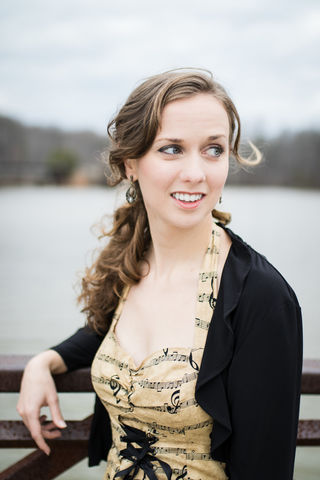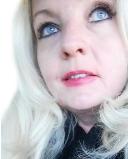Synesthesia
Unlocking Her Synesthesia Super Power
Musical artist Kendra Bragg-Harding's light blue and grey Mozart hack.
Posted August 28, 2019 Reviewed by Gary Drevitch

Talented artist, composer, and educator Kendra Bragg-Harding of North Carolina was once trying to sing Mozart's "Das Veilchen."
"It was coming out raspy and just not at all what it should have been," she recalls, though it turned out to be her most poignant and beautiful moment with synesthesia.
"I've had a lot of them, but one that was really special happened when I was studying voice in undergrad. I had a teacher, Dr. Megan McCauley, who understood synesthesia and had done a bit of research on it herself."
They worked on the passage over and over, "and I just couldn’t get it, no matter what she told me to do. Finally, she asked what color it felt. Yellow. Then she asked what color I thought it should be. Light blue/grey. She then told me to try to make it the correct color, and after a couple more tries, I got it! It was like unlocking a superpower. I’d never thought to use my synesthesia in that way, but now I do that anytime I sing. I know what colors are stressful or damaging, and what ones aren’t and I’m able to practice and adjust what I’m doing using my ears, my sense of feeling, and the colors I experience. I’m so grateful to have had a teacher who was able to think outside of the box like that."
It makes you wonder, doesn't it? How many synesthetes get stuck at that point, without an understanding and enlightened teacher?
Bragg also experiences interesting forms of the trait-like ordinal linguistic personification (OLP), where numbers have personalities, as well as object personification. "But it spills into sound, touch, taste, and smell as well," she explains. "Basically, everything I experience has its own unique personality. I have chromesthesia and grapheme-color, as well. I’m an associator, not a projector [meaning she sees the synesthesia in her mind's eye; not out in front of her]. I usually only project if I’m really not feeling well."
Like most of us synesthetes, she did not grow up aware that her inner impressions were a rare "thing." "I didn’t know there was anything 'abnormal' about how my brain worked until I was 18. I thought I might have an overactive imagination since everything had a personality, but I didn’t know synesthesia was anything other than chromesthesia. I happened to log in to a group chat when someone was talking about her synesthesia, which included OLP. That was when I realized I had it. I mentioned it to my family and found out both parents and one of my siblings are synesthetes as well!"
I had the chance recently to ask her more about her life. Some of her amazing work can be viewed here:
PT: What is your work life and music balance like?
KB: I work full-time as a musician and music educator. I teach private lessons and handle the business side of my band during the week, and gig on the weekend. I do some freelance project management as well, and compose on the side. My husband and I are both self-employed so I have a lot of flexibility with my schedule. Since music is both my passion and my business, I’m rarely ever not working on it, but I do have to remind myself to just play around with it some. Lately, I’ve been playing ukulele more, which I don’t play in the band. Taking 10 minutes here or there to just dabble with no expectations on that has been fun and helps me reset amid all of the other things I’m working on.
PT: Does synesthesia help you create your beautiful songs?
KB: Yes, both directly and indirectly. Recently I’ve written a few songs that pulled from very distinct synesthetic experiences. I’ve been listening to Denmark-based musician Ana Slivera a lot. Ana’s music is a lot of light gold and grey mixed with splashes of red, and I wanted to try and “paint” a song that was inspired by that. I sat in my car and sang nonsense lines until I hit on something that “looked right,” and continued working from there. As the lyrics started to solidify, they felt very Appalachian folk, so I started mixing in the darker reds and deep browns I hear in traditional Appalachian music. It hasn’t been recorded yet, but I’m hoping to get around to that this winter.
Synesthesia almost always factors into my concert music — my non-songwriter stuff — often influencing the direction of the piece and shaping the melody. One of the best examples of this is a guitar quartet piece I wrote years ago. I was plunking around and I came up with this neat little rocking figure that was blue and white. I associate those colors with Kate Oliphant, a guitarist, and educator and one of my best friends, so the piece seemed like her from the beginning. That gave me a sense of direction, and it became about her, factoring in colors that matched her voice and particular aspects of her personality, like her resilience. That was my first premiered piece, so it’s special for that reason, too.
More recently, I’ve been working on an electronic piece for New York-based choreographer Roza Savelyeva’s project “O.” This one is really different from anything I’ve done so far, and I’m still in the drafting phase. I’m drawing from Caroline Adelaide Shaw and Roomful of Teeth’s "Partita for 8 Voices: No. 3 Courante," the Red Room speech from David Lynch’s Twin Peaks, and various shades of green, which factors into Roza’s choreography as well. I don’t typically compose green music, but I’m having fun searching for timbres that match and syllables that evoke the same sense of motion she’s seeking to capture choreographically.
PT: Do you also experience mirror-touch synesthesia?
KB: Not really. I sometimes “feel” what an object might if it were alive, and I have a really strong connection to dancers when I watch dance, as if I were moving with them, but not the way other people experience it.
PT: Please riff on anything you like on the topic!
KB: I’ve been amazed at how many synesthetes I’ve been able to meet and work with throughout my career. It’s easy to see synesthesia as this rare, isolated thing, but I think it’s more common than we realize. If you’re curious but not sure, take the battery; it sounds way scarier than it is. It’s also really fascinating to me how many more potential types there are. I’m keeping up with David Eagleman, Richard Cytowic, you, and the rest of the gang to see what researchers uncover next! Also, if anyone knows whether or not Trey Anastasio is a synesthete, get in touch. I’m dying to know!




